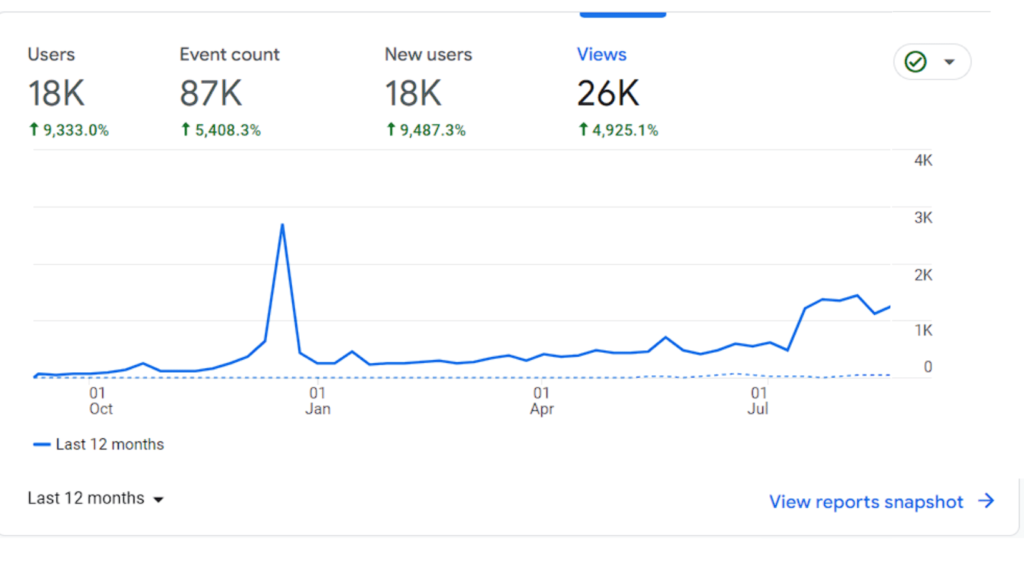Welcome to the ultimate guide to digital mastery – my comprehensive exploration of Search Engine Optimisation (SEO) in the ever-evolving digital landscape. In a world where online visibility and success are paramount, understanding SEO is not just an advantage; it’s a necessity. Join me on this exciting journey as I delve deep into the world of SEO, arming you with the knowledge and tools required to conquer the digital realm.
What is SEO?
The digital age has transformed the way we access information, connect with businesses, and make decisions. At the core of this transformation lies SEO, a fundamental aspect of the online experience. Simply put, SEO is the art and science of optimising your digital presence to be discovered and favored by search engines like Google, Bing, and Yahoo.
Imagine the internet as a vast and ever-expanding library, with billions of books (websites) on countless shelves. SEO is the map that helps you navigate this labyrinth, ensuring your book is not lost among the shelves but prominently displayed in the most frequented sections. It’s about making sure your website is seen when people search for the information, products, or services you offer.
But SEO is not a static concept; it’s a dynamic, ever-evolving field. To truly master SEO, you need to understand its roots, its evolution, and the principles that underpin it. You’ll explore the technical intricacies, the creative aspects, and the ever-shifting landscape that keeps SEO professionals on their toes.
This guide is your compass in the digital wilderness. Whether you’re a business owner aiming to boost your online presence, a digital marketer looking to sharpen your skills, or someone curious about the forces that make the internet tick, you’re in the right place. Let’s dive in!
The Genesis of SEO: Understanding its Origins
To embark on a journey of digital mastery through SEO, it’s crucial to grasp the origins of this field. Understanding how SEO came into existence and evolved over time provides essential context for its current state.
The Early Days of SEO
In the early days of the internet, websites were a novelty, and search engines were in their infancy. This digital landscape lacked the complex algorithms and intricate ranking systems we know today. It was a Wild West of sorts, where the rules were still being written.
The birth of SEO can be traced back to the mid-1990s when search engines like Yahoo, AltaVista, and WebCrawler ruled the online domain. Webmasters and site owners soon realised the importance of being found within this digital expanse. They began experimenting with various strategies to enhance their website’s visibility in search results.
The concept of optimising websites for search engines was in its infancy during this era. Early SEO pioneers recognised the need to align their web content with the algorithms of these primitive search engines. They began to tinker with elements such as meta tags, keyword stuffing, and backlinks in an attempt to improve rankings.
The Late 1990s
However, it wasn’t until the late 1990s that the term “Search Engine Optimisation” was coined, marking the official birth of this practice. SEO became a dedicated field, and professionals started to explore the art and science of improving a website’s performance in search results.
As time passed, the digital landscape evolved rapidly, and search engines became increasingly sophisticated. Google emerged as the dominant player in the search engine realm, introducing groundbreaking algorithms like PageRank. This revolutionised the way websites were ranked and emphasised the importance of quality content and valuable user experiences.
The Early 2000s
By the early 2000s, SEO had grown into a vital component of digital marketing. It was no longer a niche practice but a mainstream strategy for businesses seeking online success. The SEO industry continued to evolve, adapting to the ever-changing algorithms and ranking factors set by search engines.
Understanding this historical evolution is crucial because it lays the foundation for the SEO principles and strategies used today. SEO is not a static discipline; it’s a dynamic field that adapts to the shifts in the digital landscape. To master SEO, you must comprehend its origins, appreciate its historical context, and be prepared to evolve with it.
As we journey through this guide, you’ll explore how SEO has progressed from its early days to its current state and gain insights into the factors that shape its future. This understanding will empower you to navigate the complexities of SEO with confidence and proficiency.
The Pillars of SEO: On-Page and Off-Page Optimisation

At the core of SEO lie two fundamental pillars: on-page optimisation and off-page optimisation. Understanding these pillars is akin to comprehending the inner workings of a complex machine, each part serving a crucial purpose to achieve the desired outcome.
On-Page Optimisation: Crafting Your Digital Identity
On-page optimisation involves the strategies and techniques you implement directly on your website to enhance its visibility and ranking in search engine results. It’s about sculpting your digital identity, ensuring your website is not only attractive and user-friendly but also search engine-friendly.
This facet of SEO encompasses a multitude of elements, each contributing to the overall performance of your website. Some of the key on-page optimisation factors include:
Keyword Research and Usage
Keywords are the compass for search engines and users. Thorough keyword research helps you identify the terms and phrases your target audience is using to search for content relevant to your site. Integrating these keywords strategically into your content, meta tags, and headers can significantly boost your website’s visibility.
Quality Content
Content is king in the digital realm. Producing high-quality, informative, and engaging content is not only essential for attracting and retaining visitors but also for impressing search engines. Search engines prioritise content that answers users’ questions, provides value, and offers a seamless reading experience.
User Experience (UX) and Mobile Optimisation
The user experience is a critical ranking factor. Websites that are easy to navigate, load quickly, and provide a smooth experience across various devices, especially mobile, are favored by search engines. Ensuring your website is mobile-responsive is no longer an option but a necessity.
If you want to learn more about User Experience (UX), you can check out my article that explores this topic in detail.
Title Tags and Meta Descriptions
Crafting compelling title tags and meta descriptions is crucial for enticing users to click on your search results. These snippets not only communicate the content of your page but also act as your website’s first impression in search engine results pages (SERPs).
Internal and External Linking
Effective linking practices include both internal links (connecting to other pages within your website) and external links (referencing authoritative external sources). These connections not only guide users to relevant content but also contribute to your site’s overall authority.
Page Speed
Slow-loading pages can deter users and negatively impact rankings. Optimising your site’s speed through efficient coding, image compression, and proper hosting can make a substantial difference.
If you want to learn more about improving page speed, you can check out my article where I deep dive into the solutions of the problem.
Off-Page Optimisation: Building a Digital Reputation
While on-page optimisation focuses on your website’s internal elements, off-page optimisation extends beyond your site’s boundaries to build a digital reputation and authority. It’s about creating an online footprint that demonstrates your website’s credibility and relevance.
Key components of off-page optimisation include:
Link Building
Acquiring high-quality backlinks from reputable websites is a cornerstone of off-page optimisation. These backlinks act as digital endorsements, indicating to search engines that your site is a trusted source of information. However, it’s essential to focus on quality over quantity. A few authoritative backlinks can have a more significant impact than numerous low-quality ones.
Social Signals
Social media plays a role in off-page optimisation. The engagement, shares, and mentions your content receives on social platforms can indirectly influence your website’s authority and visibility in search results.
Online Reputation Management
Monitoring and managing your online reputation is vital. Responding to user reviews, addressing negative feedback, and maintaining a positive online image can contribute to your site’s trustworthiness.
Guest Blogging and Outreach
Collaborating with other websites through guest blogging and outreach can help you reach a broader audience and establish your expertise in your niche.
By mastering the pillars of on-page and off-page optimisation, you’ll be equipped to enhance your website’s visibility, attract organic traffic, and ascend the ranks of search engine results. SEO is a multifaceted discipline, and these foundational principles provide a strong framework for your digital mastery journey.
Technical SEO: The Backbone of Your Website

Imagine your website as a state-of-the-art sports car. While it may boast a powerful engine and sleek design, it won’t perform at its best without a solid chassis, efficient transmission, and a well-maintained infrastructure. In the digital realm, these critical components are synonymous with technical SEO.
Crawlability and Indexability: Navigating the Digital Maze
At the heart of technical SEO is ensuring that search engine bots can effectively crawl, index, and understand your website. This step is akin to creating a detailed map that guides search engines through your digital landscape.
Here are some essential technical SEO elements to consider:
XML Sitemaps
Think of XML sitemaps as your website’s navigation chart. These files provide search engines with a structured overview of your site’s content and its hierarchy. By submitting your sitemap to search engines, you’re essentially saying, “Here’s the roadmap; explore my website efficiently.”
To create an XML sitemap for your website, you can use various online tools and plugins. For example, if your website is built on WordPress, the Yoast SEO plugin can automatically generate and update your XML sitemap.
Robots.txt
The robots.txt file acts as a gatekeeper for your website. It tells search engine bots which parts of your site to access and index and which to avoid. Properly configuring your robots.txt file ensures that sensitive or duplicate content is hidden from search engines.
Creating a robots.txt file is a matter of placing a text file named “robots.txt” in your website’s root directory and specifying the directives for user agents (search engine bots). Many plugins offer such services where they will set up your robots.txt file automatically.
Canonical Tags
Canonical tags help prevent issues with duplicate content, a concern that can harm your website’s rankings. By specifying the preferred version of a page, you guide search engines to the most relevant content.
To implement canonical tags, you need to add a small snippet of HTML code to the head section of your web pages. It looks like this: <link rel="canonical" href="https://www.yourwebsite.com/your-page">.
Site Speed
As mentioned in the previous section, page speed significantly impacts user experience and rankings. Technical SEO encompasses optimising your site’s speed, which may include minifying code, enabling browser caching, and optimising images. To improve your site’s speed, you can use tools like Google PageSpeed Insights or GTmetrix to identify areas for improvement.
Structured Data Markup
Adding structured data markup to your website’s code enhances its appearance in search engine results. Rich snippets, which are more informative and visually appealing, can lead to higher click-through rates. You can implement structured data by adding specific schema.org markup to your HTML code. Google’s Structured Data Markup Helper is a user-friendly tool for generating structured data code.
Mobile Optimisation
Given the increasing number of users on mobile devices, mobile optimisation is non-negotiable. This aspect of technical SEO involves ensuring that your site is responsive and offers a seamless experience on smartphones and tablets. Many website platforms, including WordPress and Wix, offer mobile-friendly themes and templates, making it relatively easy to create a mobile-responsive site.
HTTPS Security
Google and other search engines prioritise secure websites. Migrating your site to HTTPS and securing it with an SSL certificate not only enhances user trust but also positively affects rankings. To switch to HTTPS, you’ll need to obtain an SSL certificate, configure your web server to use HTTPS, and update all internal links and resources to use the secure protocol.
Site Architecture: Building an Intuitive Blueprint
Your website’s structure is like the architectural design of a building. It dictates how users and search engines navigate through your content. A well-organised site architecture makes information easily accessible and improves user experience.
Key considerations for your site architecture include:
URL Structure
Creating clean, descriptive URLs aids both users and search engines in understanding the content of your pages. A logical URL structure also facilitates the management and maintenance of your website.
Navigation and Internal Linking
Designing intuitive navigation menus and strategically placing internal links allows users to explore your site seamlessly. This approach also ensures that search engines can discover and index your content effectively.
You can learn more about constructing the best navigation system for your site with my navigation guide.
Breadcrumb Navigation
Breadcrumb navigation is a website design element that displays a trail of links, typically near the top of a web page, to help users and search engines understand the page’s position within the site’s hierarchy. This trail of links resembles a path that users can follow back to the homepage or through the site’s various sections.
Breadcrumb navigation serves as a visual aid for users to navigate a website more easily, especially when dealing with complex or hierarchical site structures. For example, on an e-commerce site, a product page might have a breadcrumb trail like “Home > Category > Subcategory > Product,” enabling users to backtrack or jump to related pages effortlessly.
Breadcrumb navigation not only enhances user experience but also provides additional context for search engines, helping them understand the relationships between your pages. Many content management systems offer breadcrumb navigation as a built-in feature or through plugins.
Pagination
Pagination is a method used in website design and content organisation to break down lengthy content or lists of items into smaller, more manageable sections, often displayed across multiple pages. It helps improve the user experience by preventing users from scrolling through one long, overwhelming page. Instead, users can click through numbered links or buttons to access subsequent pages.
In SEO, pagination plays a crucial role in ensuring that search engines can properly index and rank your content. When content is paginated, search engines need to understand the relationships between the different pages in the sequence, ensuring that they don’t treat each page as a separate and unrelated entity. This is typically handled through the use of rel=”prev” and rel=”next” tags in the HTML code, indicating the page sequence to search engines.
For example, if you have a blog with multiple pages of articles, the first page would include a rel=”next” tag linking to the second page, and the second page would include a rel=”prev” tag linking back to the first page. This helps search engines understand the content’s pagination and ensures that the pages are treated as a connected series, not as separate and independent pages.
Structured Data: Enhancing Your Digital Identity
Schema markup, also known as structured data, is a form of microdata that you can add to your website’s HTML to provide search engines with more information about your content. This structured data helps search engines understand the context and details of your web pages. There are various types of schema markup, each tailored to specific content types, such as products, recipes, events, and organisations.
For example, if you have an e-commerce website, you can use product schema markup to provide details about the products you sell, including their names, prices, availability, and customer reviews. By implementing this markup, you’re essentially telling search engines, “This is a product, and here’s all the relevant information about it.”
Now, when a user searches for a product related to what you offer, search engines can use this structured data to display richer and more informative search results, often referred to as “rich snippets.” These results might include product images, ratings, prices, and availability directly in the search listings. Rich snippets make your content more visually appealing and provide users with immediate information, which can significantly increase the chances of them clicking through to your website.
How to Add Schema Markup
Adding schema markup to your website can be done manually by editing the HTML code of your web pages, or you can use specialised tools and plugins to generate the markup. Here’s how you can add schema markup to your website:
Identify the Appropriate Schema Type
Determine the type of content you want to mark up. Common schema types include products, recipes, events, organisations, and more. Choose the schema type that corresponds to the content on your web page.
Generate the Markup
There are several ways to generate schema markup:
Manual Coding: You can write the markup directly into the HTML code of your web pages. You’ll need to follow the schema.org guidelines and add specific tags, attributes, and values to your content. This method requires a good understanding of HTML and structured data.
Schema Markup Generators: There are online tools and schema markup generators that can help you create structured data without manual coding. These tools often provide a user-friendly interface where you input your content details, and they generate the appropriate markup for you.
SEO Plugins: If you’re using a content management system (CMS) like WordPress, there are SEO plugins available (e.g., Yoast SEO, Rank Math) that offer schema markup functionality. These plugins allow you to add structured data to your content using a simple interface, and they take care of generating the markup for you.
Add the Markup to Your HTML
If you’re using manual coding or a markup generator, you’ll need to add the generated schema markup to the HTML code of your web pages. This is usually done in the <script> tags or in the <head> section of the page.
Validate Your Markup
It’s essential to validate your schema markup to ensure it’s error-free and adheres to schema.org guidelines. You can use Google’s Structured Data Testing Tool or other validation tools to check for any issues.
Submit to Search Engines
Once your schema markup is in place and validated, you can submit your updated pages to search engines. Google, for example, provides a structured data testing tool and a search console where you can submit your markup for indexing.
Local SEO: Dominating the Local Search Scene

Local SEO is a powerful tool for businesses looking to connect with their nearby audience. Whether you run a brick-and-mortar store, a local service business, or a national company with multiple locations, optimising for local search is crucial. It allows you to target users in your area, increase foot traffic, and generate more local leads.
Here’s how you can dominate the local search scene with effective local SEO strategies:
1. Google My Business (GMB) Optimisation
Claim and verify your Google My Business listing. Ensure all your business information is accurate, including your name, address, phone number, website, hours of operation, and business category. Regularly update your GMB profile with photos, posts, and customer reviews.
2. On-Page SEO with Local Keywords
Optimise your website’s on-page elements with local keywords. Include your location in title tags, meta descriptions, and content. Create location-specific landing pages if you have multiple locations.
3. NAP Citations
Ensure consistent Name, Address, and Phone (NAP) information across all online platforms, including local business directories, social media, and your website. Inconsistent NAP information can harm your local SEO efforts.
4. Local Link Building
Build high-quality local backlinks from reputable websites in your area. Join local business organisations, participate in community events, and sponsor local charities or teams to earn local links.
5. Online Reviews
Encourage customers to leave reviews on your GMB profile and other review platforms. Respond to reviews, both positive and negative, to show your commitment to customer satisfaction.
6. Mobile Optimisation
Local searches often occur on mobile devices, so ensure your website is mobile-friendly. Google prioritises mobile-responsive websites in its rankings.
7. Local Schema Markup
Implement schema markup to provide search engines with structured data about your business, such as your address, phone number, business hours, and more. This can result in rich snippets in search results, making your listings more informative and appealing to users.
8. Content Localisation
Create content that caters to local interests and issues. This can include blog posts about local events, news, or customer stories. The more relevant and engaging your content is, the more likely it is to attract local users.
Local SEO is a dynamic field, and staying competitive requires ongoing effort and adaptation. By implementing these strategies and staying up-to-date with the latest local SEO trends and algorithm changes, you can dominate the local search scene and connect with your local audience effectively.
Content Marketing and SEO

Welcome to the dynamic intersection of content marketing and SEO. This exciting convergence is where the magic happens. SEO, with all its technical intricacies, meets the art of storytelling and engaging an audience. In this section, we delve into how to synergise your SEO strategies with content marketing for maximum impact.
1. The Power of Content
First and foremost, let’s underscore the importance of content in the realm of SEO. Search engines aim to deliver the most relevant and valuable results to users. Your content is at the heart of this mission. The more informative, engaging, and well-structured your content is, the higher the likelihood of ranking well in search results.
2. Keywords and Content Strategy
When developing your content marketing strategy, keyword research is your compass. You need to understand the language your audience uses when searching for information. Integrate these keywords strategically into your content, ensuring a natural flow that provides value to your readers.
3. Quality and Relevance
Search engines, especially Google, are getting smarter at discerning content quality. Your content should be informative, credible, and relevant to the search intent. Avoid thin, low-value content that merely exists to stuff keywords.
4. User Experience Matters
User experience (UX) is a crucial SEO factor. Your content should be easily navigable, mobile-friendly, and visually appealing. When visitors spend more time on your site and consume more content, search engines take notice.
5. SEO-Friendly Writing
Learn the art of SEO-friendly writing. This involves crafting content that speaks to both your audience and search engines. Striking the right balance can be challenging but highly rewarding.
6. Link Building and Content
Quality content naturally attracts backlinks from other websites. As part of your content marketing strategy, focus on acquiring high-quality backlinks. Building a network of authoritative sites that link to your content can boost your SEO performance.
7. Guest Blogging and Outreach
Guest blogging is a valuable content marketing tactic. Writing for other reputable websites in your niche not only exposes your brand to a wider audience but also provides opportunities for backlinks.
8. Content Promotion
Creating great content is only half the battle. Promoting it is equally essential. Leverage social media, email marketing, and other promotional channels to get your content in front of your target audience.
9. Measuring Content Performance
Use tools like Google Analytics to monitor the performance of your content. Pay attention to metrics such as page views, bounce rates, and time spent on your pages. This data helps you refine your content marketing strategy.
10. The Content SEO Cycle
Understand that content marketing and SEO are not one-off tasks. They form a continuous cycle of creation, optimisation, promotion, measurement, and improvement. A successful content SEO strategy is an ongoing commitment to delivering value to your audience.
SEO Tools and Resources

In the ever-evolving realm of SEO, having the right tools and resources at your disposal can make a world of difference. Whether you’re an SEO newbie or a seasoned pro, the right toolkit can streamline your efforts and help you achieve more with less.
1. Keyword Research Tools
- Google Keyword Planner: A free tool from Google, it’s great for generating keyword ideas and estimating search volumes.
- SEMrush: A comprehensive SEO tool that includes powerful keyword research features.
- Ahrefs: Known for its robust backlink analysis, Ahrefs is also a fantastic keyword research tool.
2. On-Page SEO Tools
- Yoast SEO: A popular WordPress plugin for optimising on-page SEO.
- Moz On-Page Grader: Provides recommendations for optimising specific pages.
- Screaming Frog SEO Spider: A desktop program that analyses your website’s on-page elements.
3. Link Building Tools
- BuzzStream: Ideal for managing outreach and building relationships with influencers.
- Hunter.io: Helps you find email addresses for outreach.
- Pitchbox: A platform for streamlined outreach campaigns.
4. Analytics Tools
- Google Analytics: The go-to tool for understanding your website’s traffic and user behavior.
- Google Search Console: Offers insights into how Google views your site and helps diagnose issues.
- Moz Pro: Provides comprehensive site analytics and SEO insights.
5. Content Marketing Tools
- HubSpot: A comprehensive inbound marketing platform.
- CoSchedule Headline Analyser: Helps you craft engaging and SEO-friendly headlines.
- BuzzSumo: A tool for finding popular content in your niche.
6. Technical SEO Tools
- Google PageSpeed Insights: Checks your website’s loading speed and offers suggestions for improvement.
- GTmetrix: Another tool for analysing and optimising page load times.
7. Local SEO Tools
- Moz Local: Manages your local business listings and online reputation.
- BrightLocal: A comprehensive platform for local search marketing.
- Whitespark: Specialises in local search and citation building.
8. Learning Resources
- Digital Mastery Series: Offers a treasure trove of SEO resources, from beginner’s guides to advanced SEO techniques.
- Search Engine Land: A trusted source for staying updated on SEO news and trends.
- Moz Whiteboard Friday: A video series covering various SEO topics.
9. Forums and Communities
- Google Webmaster Central Help Community: Great for getting answers to specific questions.
- Moz Q&A Forum: A community of SEO enthusiasts discussing various topics.
- Reddit SEO: An active subreddit for SEO discussions.
10. SEO Plugins for CMS
- Yoast SEO (WordPress): Enhances your WordPress site’s SEO.
- All in One SEO Pack (WordPress): Another popular SEO plugin for WordPress.
11. SEO Courses and Certifications
- Moz Academy: Offers a range of SEO courses.
- Coursera Google SEO Specialisation: A comprehensive series of SEO courses.
- HubSpot Academy: Provides free SEO courses.
Equipped with the right tools and resources, you’re ready to tackle SEO challenges with confidence. This section has provided an overview of essential tools and learning resources to bolster your SEO journey. Whether you’re optimising your website for better search rankings or delving into the complexities of technical SEO, these tools and resources will prove invaluable on your path to SEO mastery.
Measuring and Monitoring SEO Success

In the world of SEO, what gets measured gets managed. Measuring and monitoring SEO success is paramount to understanding the effectiveness of your strategies, identifying areas for improvement, and demonstrating the value of your efforts to stakeholders. This section delves into the crucial aspects of tracking your SEO performance.
1. Key Performance Indicators (KPIs)
Before embarking on your SEO journey, it’s essential to establish clear Key Performance Indicators (KPIs) to track your progress. These KPIs will serve as benchmarks for evaluating your SEO efforts. Common SEO KPIs include:
- Organic Traffic: The number of visitors coming to your website through search engine results.
- Keyword Rankings: Monitoring your rankings for specific keywords.
- Conversion Rate: How well your website converts visitors into customers.
- Bounce Rate: The percentage of visitors who leave your site after viewing only one page.
- Click-Through Rate (CTR): The percentage of users who click on your search result from the total number of users who view it.
2. Google Analytics

Google Analytics is a robust tool that provides in-depth insights into your website’s performance. It helps you understand where your visitors are coming from, what they do on your site, and whether your SEO efforts are bearing fruit. Key reports and features in Google Analytics include:
- Audience Overview: Offering insights into your website’s users.
- Acquisition: Showing where your website traffic is coming from, be it organic search, referral, direct, or social.
- Behavior: Detailing what your visitors do on your site.
- Conversions: Tracking goals and conversions, such as form submissions, e-commerce transactions, and more.
3. Google Search Console
Google Search Console is a must-have tool for webmasters and SEO professionals. It provides valuable data directly from Google, offering insights into how your site performs in Google search results. Here’s what you can do with Google Search Console:
- Submit Sitemaps: Help Google discover and index your pages by submitting sitemaps.
- Check Index Coverage: Ensure your website’s pages are indexed correctly and identify issues.
- Performance Report: See how your site is performing in Google Search and which queries drive traffic.
- URL Inspection: Inspect a specific URL to check if it’s indexed and whether there are issues.
4. SEO Reporting Tools
Various SEO reporting tools can help you visualise and analyse your data. These tools simplify the process of generating reports and presenting your findings to stakeholders. Examples of such tools include:
- Google Data Studio: Create custom, interactive reports with data from Google Analytics, Google Search Console, and more.
- Moz Pro: Offers a variety of SEO reports, from site audits to rank tracking.
- SEMrush: Provides a suite of SEO reporting tools, including domain analytics and position tracking.
5. SEO Auditing Tools
SEO auditing tools help you identify issues on your website and offer suggestions for improvement. Some popular options include:
- Screaming Frog SEO Spider: Crawls your website to find on-page SEO issues, broken links, and more.
- Ahrefs Site Audit: Offers an extensive site audit tool to uncover SEO issues.
- Semrush Site Audit: Provides site health checks, including issues and warnings.
6. Competitor Analysis
Competitor analysis is a valuable part of monitoring your SEO performance. It helps you understand your position in the market and uncover opportunities. Tools like SEMrush and Ahrefs offer features to analyse competitors’ keywords, backlinks, and overall strategies.
7. Data Analysis and Optimisation
Data analysis is the key to improvement. Regularly review the data and insights from Google Analytics, Google Search Console, and other reporting tools to identify trends, spot problems, and fine-tune your SEO strategies.
The next section will explore the ever-evolving landscape of SEO trends and future insights, providing you with a glimpse into what lies ahead in the world of search engine optimisation.
Common SEO Mistakes to Avoid

In the ever-evolving world of SEO, there are countless strategies to boost your website’s visibility and rankings in search engines. However, along the way, it’s easy to make mistakes that can hinder your progress and even lead to detrimental consequences. Here, we’ll explore some of the most common SEO mistakes that you should steer clear of as you navigate the SEO landscape.
1. Ignoring Mobile Optimisation
With the increasing use of mobile devices, having a mobile-responsive website is crucial. Neglecting mobile optimisation can lead to a poor user experience and negatively impact your search rankings.
2. Neglecting Page Speed
Slow-loading pages can drive visitors away and harm your search engine rankings. Ensure your website loads quickly to keep both users and search engines satisfied.
3. Keyword Stuffing
Keyword optimisation is essential, but overusing keywords (keyword stuffing) can result in penalties from search engines. Focus on providing valuable content rather than cramming keywords.
4. Duplicate Content
Duplicate content across your site can confuse search engines and harm your rankings. Ensure that your content is unique and provides value to your audience.
5. Neglecting Local SEO
If you have a physical business location, ignoring local SEO can hinder your visibility to local customers. Optimise your Google My Business listing and use local keywords to reach nearby audiences.
6. Skipping Title Tags and Meta Descriptions
Title tags and meta descriptions provide vital information to both users and search engines. Avoid skipping them; they can significantly impact your click-through rates.
7. Neglecting User Experience (UX)
A poor user experience, including confusing navigation and a lack of mobile-friendliness, can lead to higher bounce rates and decreased rankings.
8. Not Monitoring Analytics
Failing to monitor your website’s performance through analytics tools means missing out on essential insights. Regularly review data to identify areas that need improvement.
9. Overlooking Image Optimisation
Images add value to your content, but failing to optimise them for SEO can lead to missed opportunities. Use descriptive alt tags and compress images to enhance page load speed.
10. Neglecting Quality Backlinks
While backlinks are crucial for SEO, quality matters more than quantity. Acquiring spammy or irrelevant backlinks can harm your site’s reputation.
11. Lack of Fresh Content
Stagnant websites with no fresh content may not rank as well as those with regular updates. Maintain a content schedule to keep your site relevant.
12. No Social Media Presence
Social signals can impact your SEO rankings. Neglecting a social media presence means missing opportunities to engage with your audience and boost your website’s credibility.
By avoiding these common SEO mistakes and focusing on best practices, you’ll be on the right path to improving your website’s search engine rankings and delivering an exceptional user experience. Remember that SEO is an ongoing process, and staying informed about industry changes and adapting your strategies is key to long-term success.
Frequently Asked Questions (FAQs)
As we delve into the world of SEO, it’s natural to have questions and seek clarification on various aspects. Here, we’ll address some of the most frequently asked questions about SEO, providing you with the insights you need to navigate this complex but rewarding digital landscape.
Q1: What Is SEO, and Why Is It Important?
SEO, or Search Engine Optimisation, is a set of strategies and techniques used to improve a website’s visibility on search engines like Google. Its importance lies in the fact that it helps your website rank higher in search results, driving more organic (unpaid) traffic to your site. This, in turn, can lead to increased brand visibility, more leads, and higher conversion rates.
Q2: How Long Does It Take to See SEO Results?
The time it takes to see SEO results can vary based on various factors, including the competitiveness of your industry and the strategies you implement. Generally, you can start to see some improvements within a few months, but significant results may take six months to a year or longer. SEO is an ongoing process that requires patience.
Q3: What Are Keywords, and How Should I Use Them?
Keywords are the words and phrases that people type into search engines. Proper keyword research helps you identify which keywords are relevant to your content. These keywords should be used naturally in your content, in titles, headers, and meta descriptions to make it easier for search engines to understand what your page is about.
Q4: Do I Need to Hire an SEO Professional?
While you can learn and implement SEO techniques yourself, hiring an SEO professional or agency can be beneficial, especially if you lack the time or expertise. They can provide valuable insights, save you time, and ensure your strategies align with best practices.
If you are interested in learning more about the services that my digital agency provides you can head over to our agency website.
Q5: Are Backlinks Still Important for SEO?
Yes, backlinks remain crucial for SEO. They are like “votes of confidence” from other websites that indicate the quality and relevance of your content. Quality backlinks can significantly impact your rankings. However, it’s essential to focus on natural, high-quality backlinks rather than spammy ones.
Q6: What Is Local SEO, and How Does It Differ from Regular SEO?
Local SEO focuses on optimising your website to appear in local search results. It’s particularly important for brick-and-mortar businesses targeting local customers. Strategies include creating a Google My Business listing, using local keywords, and acquiring reviews.
Q7: How Can I Keep Up with SEO Changes?
SEO is a dynamic field with frequent updates and changes. Staying updated is crucial. You can follow reputable SEO blogs, participate in webinars, and join SEO forums. Additionally, subscribing to Google’s official webmaster channels can provide you with essential insights.
Q8: Is SEO a One-Time Effort or an Ongoing Process?
SEO is an ongoing process. Search engines frequently update their algorithms, and competitors can adapt to the changing landscape. Continuous monitoring and adjustments are necessary to maintain and improve your rankings.
Q9: Can I Achieve SEO Success Without Quality Content?
Quality content is at the core of SEO success. While other strategies are essential, your content is what attracts and engages visitors. High-quality, informative, and valuable content not only pleases your audience but also search engines.
Q10: What’s the Biggest SEO Mistake to Avoid?
One of the most significant SEO mistakes to avoid is ignoring best practices and relying on outdated techniques. SEO evolves, and keeping up with the latest trends is crucial for long-term success.
Conclusion
In my comprehensive guide to SEO, we’ve explored the intricate world of search engine optimisation, revealing the strategies, techniques, and best practices that can enhance your online presence and drive success. As we conclude this journey, it’s vital to reflect on the enduring significance of SEO in the digital landscape.
SEO remains a cornerstone of digital marketing, ensuring that your content, products, and services are discoverable by the right audience. With the ever-increasing competition online, the role of SEO in helping you stand out and achieve your online goals cannot be overstated.
Remember that SEO is not a one-time effort but an ongoing process. It requires dedication, continuous learning, and adaptation to the ever-evolving algorithms of search engines. Whether you’re an entrepreneur, a marketer, a website owner, or simply someone interested in the digital realm, the knowledge and skills you’ve gained here are invaluable.
I encourage you to take the insights from this guide and apply them to your digital endeavors. Harness the power of keywords, create compelling and informative content, optimise your website for speed and mobile devices, and engage in ethical and quality link-building. These are the building blocks of a robust SEO strategy.
Thank you for joining me on this enlightening journey through the world of SEO. May your digital endeavors be prosperous, and may your SEO efforts yield fruitful results. If you have more questions or need assistance, feel free to explore my other resources or reach out to me for further guidance.
Further Reading
Crafting a Compelling About Us Page: Dive deeper into the art of telling your brand’s story with the perfect “About Us” page. Learn to engage your audience and establish a meaningful connection through storytelling.
Website Design and User Experience: Explore the world of website design and user experience, where aesthetics and functionality combine to create a seamless, engaging web journey for your audience. Learn how to make your website visually appealing and user-friendly.
Responsive Web Design: Ensuring Mobile Compatibility: In the mobile-first era, it’s crucial to ensure your website is fully compatible with various devices. Discover the principles and techniques for responsive web design, making your site look and work flawlessly on smartphones, tablets, and desktops.















